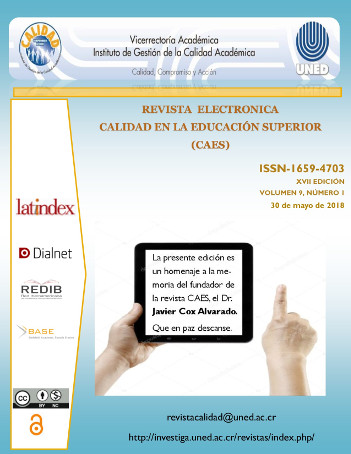Characteristics of an innovative educational project: an academic challenge at the master´s level
DOI:
https://doi.org/10.22458/caes.v9i1.2086Abstract
This paper is aimed by three students of the Master in Technology and Educational Innovation (MATIE) of the National University of Costa Rica (UNA). It presents some concepts and characteristics related to educational innovation, in order to guide the academic practices of those who wish to initiate an innovative project within an educational context, especially if it is part of the training process in the MATIE in Technology and Educational Innovation MATIE) of the National University (UNA), as it is part of the graduation requirements. In order to carry out this research, bibliographical revisions of the terms were reviewed, official documents were consulted, the experiences of the participants of the masters were presented, and the academic, administrative, teachers and graduates of MATIE were interviewed with the purpose of generating a concrete vision on the characteristics, advantages and the management concerning an innovative project. In this research, the concept of educational innovation is basic. Francisco Imbernón (1996) explains that “educational innovation is the attitude and the process of inquiry of new ideas, proposals and contributions, carried out collectively, for the solution of problematic situations of the practice, which will entail a change in the contexts and in the institutional practice of education.” Based on information gathered at the teaching, administrative and student levels of MATIE, it is also important to outline the innovative person, characteristics and performance in activities related to the technological development and its performance in several levels and modalities of education. In conclusion, MATIE provides the opportunity to develop and take advantage of ICT for the design, construction and evaluation of learning environments face-to-face, bimodal and virtual. This prompts the graduates to be managers of online learning environments that promote the overcoming of barriers and limitations that education faces, in order to generate new scenarios and manage processes that facilitate new models and training strategies.
References
Azevedo, R., Cromley, J. y Seibert, D. (2004). Does adaptive scaffolding facilitate students ability to regulate their learning with hypermedia? Contemporary Educational Psychology, 29, 344-370. doi: 10.1016/j.cedpsych.2003.09.002
Barraza, A., Cárdenas, J. y Hernández, C. (2013). ¿Cómo elaborar proyectos de innovación educativa? México: Universidad Pedagógica de Durango. Recuperado de http://www.facultadeducacion.ucr.ac.cr/documentos/doc_download/58-icomo-elaborar-proyectos-de-innovacion-educativa
Barraza-Macías, A. (2005). Una conceptualización comprehensiva de la innovación educativa. Innovación Educativa, 5 (28), 19-31.
Citas Favoritas (2015) Terry Neill. ¡Ábrete libro! Foro sobre libros y autores. Recuperado de
http://www.abretelibro.com/foro/viewtopic.php?f=33&t=256&start=2880
Consejo Nacional de Rectores (CONARE). (2010). Plan Nacional de Educación Superior 2011-2015 (Propuesta inicial). San José, Costa Rica: CONARE.
De la Torre, S. (1998). Cómo innovar en los centros educativos. Estudios de casos. Barcelona: Escuela Española.
Madriz, M. y Navarro, S. (2012). Sensibilidad, Afectividad y Reflexión en las Aulas: Una Carencia en la Labor Docente. Revista Ensayos Pedagógicos, VII (2), 57-66.
PROGESTIC (2016). Descripción General de la MATIE. Recuperado de http://www.progestic.una.ac.cr/posgrados/maestriaen-tecnologia-e-innovacion-educativa-matie/descripcion-general.html
PROGESTIC (2016). Lineamientos del Proyecto de Innovación de la MATIE. Recuperado de http://www.progestic.una.ac.cr/posgrados/maestria-en-tecnologia-einnovacion-educativa-matie/lineamientos-para-proyecto-final-degraduacion.html
PROGESTIC (2016). Perfil del egresado de la MATIE. Recuperado de http://www.progestic.una.ac.cr/posgrados/maestriaen-tecnologia-e-innovacion-educativa-matie/perfiles.html
PROGESTIC (2016). Colección de Trabajos Finales de Graduación MATIE. Recuperado de http://www.repositorio.una.ac.cr/handle/11056/8668
Rimari, W. (2002). La Innovación Educativa, instrumento de desarrollo. Recuperado de
http://www.uaa.mx/direcciones/dgdp/defaa/descargas/innovacion_e ducativa_octubre.pdf
Rodríguez, K. (2017). Creación de un Cubículo Virtual de aprendizaje distribuido para el curso de Recursos Informáticos de la Universidad Técnica Nacional para el 2017. (Proyecto Final de Maestría). Heredia, Costa Rica: Universidad Nacional de Costa Rica.
Siemens, G. (2005, enero). Connectivism: A learning theory for the digital age. International Journal of Instructional Technology and Distance Learning, (2). Recuperado de http://www.itdl.org/journal/jan_05/index.htlm
Silvio, J. (2004). Tendencias de la educación superior virtual en América Latina y el Caribe. IESALC/UNESCO (Eds.). La educación superior virtual en América Latina y el Caribe, 5-27. Recuperado de http://tecnologiaedu.us.es/bibliovir/pdf/EducVirtual.pdf
Simonson, M., Smaldino, S., Albright, M. y Zvacek, S. (2006). Teaching and learning at a distance: Foundations of distance education (3ªEd.). Upper Saddle River, N.J., EE.UU.: Pearson Prentice Hall.
Tecnológico de Monterrey (2014). Primer Congreso Internacional de Innovación Educativa. Recuperado de https://drive.google.com/a/itesm.mx/file/d/0Bxu5PCww2WDQSnAtb mRmN0FXejg/view?ts=566cbf03
Universidad Estatal a Distancia (UNED). (junio 2011). Plan de Desarrollo Institucional 2011-2015: Para el fortalecimiento de la educación a distancia. Aprobado por el Consejo Universitario, sesión 2101-2011. San José, Costa Rica: Vicerrectoría de Planificación de la UNED.
UNESCO. (2016), Tecnologías de la Información y la Comunicación, TIC, para el aprendizaje. Recuperado de http://www.unesco.org/new/fileadmin/MULTIMEDIA/FILE/Santiago/pdf/apuntes3-2014.pdf
UNESCO. (2014). Innovación. Educativa. Serie “Herramientas de apoyo para el trabajo docente” Recuperado de http://www.cne.gob.pe/images/stories/cne-publicaciones/AvancesPEN.pdf.
UNESCO. (2008). “La Educación Inclusiva: El Camino Hacia el Futuro”. Conferencia internacional de educación cuadragésima octava reunión. Recuperado de http://www.ibe.unesco.org/fileadmin/user_upload/Policy_Dialogue/48th_ICE/CONFINTED_48-5_Conclusions_spanish.pdf
UNESCO. (1998). Declaración Mundial Sobre la Educación Superior en el Siglo XXI: Visión y Acción; y Marco de Acción prioritaria para el Cambio y el Desarrollo de la Educación Superior. En Conferencia Mundial Sobre la Educación Superior. La Educación Superior en el siglo XXI: Visión y Acción. París. Recuperado de http://www.unesco.org/education/educprog/wche/declaration_spa .htm
Universidad Veracruzana (2016). Innovación Educativa. Recuperado de https://www.uv.mx/blogs/innovaedu/que-es-innovacion-educativa/objetivos/
Wagner, T. (2012). Creating innovators: The making of young people who will change the world. New York, EE.UU.: Ed. Simon, Schuster Inc.
Downloads
Published
How to Cite
Issue
Section
License
Esta revista provee acceso libre inmediato a su contenido bajo el principio de que hacer disponible gratuitamente la investigación al publico, lo cual fomenta un mayor intercambio de conocimiento global.
